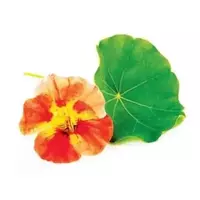Nasturtium

Nasturtius or as it is also called capuchin belongs to the nasturtius family. This annual herb is distinguished by its fleshy, highly branched stem and thyroid leaves. Nasturtium flowers are unusually delicate, they are colored orange, red and yellow.
Interestingly, the long spur, which is present in colors, makes them similar to the hoods of monks who belong to the Capuchin order. By the way, in German, capuchin means a pointed hood. By the autumn period, bright flowers turn into fruits, which are boxes of seeds.
Residents of European countries first learned about nasturtium back in the 16th century, when this interesting plant under the guise of watercress arrived from South America. The plant quickly and firmly entered the menu of the population of Europe and Asia, where not only excellent gastronomic qualities are known, but also the healing properties of nasturtium.
According to some estimates, biology experts today distinguish about 80 varieties of nasturtium, each of which is native to South America. Today this plant can be found everywhere - it is cultivated in Central Asia, the Caucasus and the European part of our country. For residents of most countries, nasturtia is an attractive ornamental plant.
As a vegetable crop, nasturtium was grown and eaten by the inhabitants of Ancient Rome. The leaves of this plant have a tart bitter taste, so dishes based on it are characterized by sharpness and can arouse appetite. Often this spicy plant is used as a seasoning for soups, meat dishes or vegetables. In an unadorned form, nasturtium seeds can perfectly replace mustard.
Ground fresh root leaves are mainly used to make peppery-flavored sauces, and thanks to the special aromatic properties of nasturtium, young stems and leaves help to endow sandwiches and vinaigrettes with a pleasant accent. Flower buds and buds, as well as immature fruits, are often pickled with tarragon and vinegar - the result is a good seasoning, which is perfectly combined with sharp sauces, pickled herring, dishes of tomatoes, cucumbers, Brussels sprouts and scallops.
In addition, in Armenia, nasturtium leaves are a component of many flour dishes, while young shoots are usually salted and pickled there. The French traditionally decorate fresh salads, mashed soups and some drinks with nasturtium flowers. Large seeds that resemble wrinkled nuts in their appearance are boiled by local chefs in vinegar, after which they are used as a fragrant seasoning for meat dishes.
nasturtium 22 kCal
Energy value of nasturtium (Ratio of proteins, fats, carbohydrates - ju):
Proteins: 3.58 g (~ 14 kCal)
Fats: 0.6 g (~ 5 kCal)
Carbohydrates: 0.8 g (~ 3 kCal)
Energy ratio (bj | y): 65% | 25% | 15%
 Español
Español Français
Français Português
Português Русский
Русский 简体中文
简体中文 繁體中文
繁體中文 日本語
日本語 한국어
한국어 العربية
العربية Türkçe
Türkçe Қазақ
Қазақ Deutsch
Deutsch Italiano
Italiano Українська
Українська
